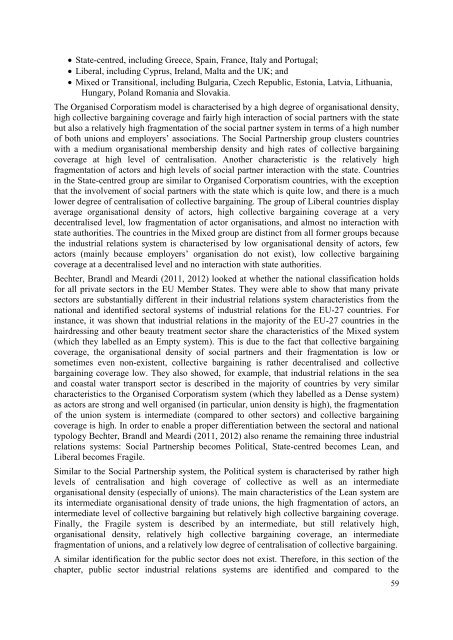Industrial Relations in Europe 2012 - European Commission - Europa
Industrial Relations in Europe 2012 - European Commission - Europa
Industrial Relations in Europe 2012 - European Commission - Europa
You also want an ePaper? Increase the reach of your titles
YUMPU automatically turns print PDFs into web optimized ePapers that Google loves.
State-centred, <strong>in</strong>clud<strong>in</strong>g Greece, Spa<strong>in</strong>, France, Italy and Portugal;<br />
Liberal, <strong>in</strong>clud<strong>in</strong>g Cyprus, Ireland, Malta and the UK; and<br />
Mixed or Transitional, <strong>in</strong>clud<strong>in</strong>g Bulgaria, Czech Republic, Estonia, Latvia, Lithuania,<br />
Hungary, Poland Romania and Slovakia.<br />
The Organised Corporatism model is characterised by a high degree of organisational density,<br />
high collective barga<strong>in</strong><strong>in</strong>g coverage and fairly high <strong>in</strong>teraction of social partners with the state<br />
but also a relatively high fragmentation of the social partner system <strong>in</strong> terms of a high number<br />
of both unions and employers’ associations. The Social Partnership group clusters countries<br />
with a medium organisational membership density and high rates of collective barga<strong>in</strong><strong>in</strong>g<br />
coverage at high level of centralisation. Another characteristic is the relatively high<br />
fragmentation of actors and high levels of social partner <strong>in</strong>teraction with the state. Countries<br />
<strong>in</strong> the State-centred group are similar to Organised Corporatism countries, with the exception<br />
that the <strong>in</strong>volvement of social partners with the state which is quite low, and there is a much<br />
lower degree of centralisation of collective barga<strong>in</strong><strong>in</strong>g. The group of Liberal countries display<br />
average organisational density of actors, high collective barga<strong>in</strong><strong>in</strong>g coverage at a very<br />
decentralised level, low fragmentation of actor organisations, and almost no <strong>in</strong>teraction with<br />
state authorities. The countries <strong>in</strong> the Mixed group are dist<strong>in</strong>ct from all former groups because<br />
the <strong>in</strong>dustrial relations system is characterised by low organisational density of actors, few<br />
actors (ma<strong>in</strong>ly because employers’ organisation do not exist), low collective barga<strong>in</strong><strong>in</strong>g<br />
coverage at a decentralised level and no <strong>in</strong>teraction with state authorities.<br />
Bechter, Brandl and Meardi (2011, <strong>2012</strong>) looked at whether the national classification holds<br />
for all private sectors <strong>in</strong> the EU Member States. They were able to show that many private<br />
sectors are substantially different <strong>in</strong> their <strong>in</strong>dustrial relations system characteristics from the<br />
national and identified sectoral systems of <strong>in</strong>dustrial relations for the EU-27 countries. For<br />
<strong>in</strong>stance, it was shown that <strong>in</strong>dustrial relations <strong>in</strong> the majority of the EU-27 countries <strong>in</strong> the<br />
hairdress<strong>in</strong>g and other beauty treatment sector share the characteristics of the Mixed system<br />
(which they labelled as an Empty system). This is due to the fact that collective barga<strong>in</strong><strong>in</strong>g<br />
coverage, the organisational density of social partners and their fragmentation is low or<br />
sometimes even non-existent, collective barga<strong>in</strong><strong>in</strong>g is rather decentralised and collective<br />
barga<strong>in</strong><strong>in</strong>g coverage low. They also showed, for example, that <strong>in</strong>dustrial relations <strong>in</strong> the sea<br />
and coastal water transport sector is described <strong>in</strong> the majority of countries by very similar<br />
characteristics to the Organised Corporatism system (which they labelled as a Dense system)<br />
as actors are strong and well organised (<strong>in</strong> particular, union density is high), the fragmentation<br />
of the union system is <strong>in</strong>termediate (compared to other sectors) and collective barga<strong>in</strong><strong>in</strong>g<br />
coverage is high. In order to enable a proper differentiation between the sectoral and national<br />
typology Bechter, Brandl and Meardi (2011, <strong>2012</strong>) also rename the rema<strong>in</strong><strong>in</strong>g three <strong>in</strong>dustrial<br />
relations systems: Social Partnership becomes Political, State-centred becomes Lean, and<br />
Liberal becomes Fragile.<br />
Similar to the Social Partnership system, the Political system is characterised by rather high<br />
levels of centralisation and high coverage of collective as well as an <strong>in</strong>termediate<br />
organisational density (especially of unions). The ma<strong>in</strong> characteristics of the Lean system are<br />
its <strong>in</strong>termediate organisational density of trade unions, the high fragmentation of actors, an<br />
<strong>in</strong>termediate level of collective barga<strong>in</strong><strong>in</strong>g but relatively high collective barga<strong>in</strong><strong>in</strong>g coverage.<br />
F<strong>in</strong>ally, the Fragile system is described by an <strong>in</strong>termediate, but still relatively high,<br />
organisational density, relatively high collective barga<strong>in</strong><strong>in</strong>g coverage, an <strong>in</strong>termediate<br />
fragmentation of unions, and a relatively low degree of centralisation of collective barga<strong>in</strong><strong>in</strong>g.<br />
A similar identification for the public sector does not exist. Therefore, <strong>in</strong> this section of the<br />
chapter, public sector <strong>in</strong>dustrial relations systems are identified and compared to the<br />
59

















